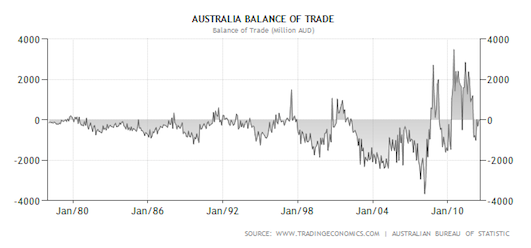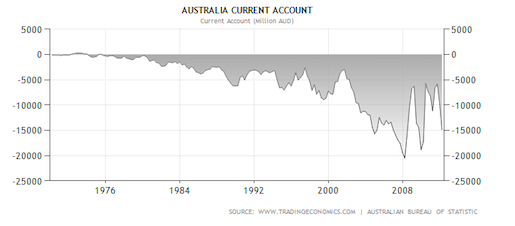Back in March I wrote a set of 3 posts to provide some macro-level analysis and clarity of the Australian economy in what I saw as the somewhat confusing view of our country’s financial position. The confusion was being caused by the political rhetoric that our economy was world leading on the back of the mining investment boom yet many Australians didn’t feel that this was the case.
If you have time then please go back and read these posts, but in case you don’t the general overview was:
- The mining boom is having a positive influence on national income, but its magnitude is insufficient to offset the larger outflows of interest payments and profits to non-residents as a result of over three decades of growth in external debt.
- Private sector credit growth has been the major influencing factor in national income growth over the last few decades, but its rate of growth is slowing as households change their preferences towards saving over consumption after the GFC.
- The government initially offset the private sector’s change in consumption preferences by increasing government spending. This has now stopped, as the government has set an agenda for surpluses.
As you may have noticed over the last couple of weeks there has been some commentary on MB, among other sources, about the over-strength of the Australian dollar, along with some concern about the continued strength of the mining boom and other economic indicators.
Although these events may appear disconnected, they are actually fundamental to what is driving the macroeconomic settings of the Australian economy.
As I have covered before, Australia has been running a current account deficit since the mid 70s. A current account deficit means that the country is a net borrower from the rest of the world. In that context Australia has continual net financial capital inflow to offset this deficit as we have tended to import more than we export in dollar terms for nearly 30 years.
Over the last few years Australia has seen a large improvements in the terms of trade due to rising global commodity prices. This has led to increased export revenue which has lifted the balance of trade. The following chart may, however, put that in some context:
As H&H has been actively covering, the prices of Australia’s major resource exports are now receding which in itself is beginning to turn the balance of trade back towards the negative. Trades in goods and services , however, isn’t the only part of the current account.
Australia has also until quite recently had a low level of private sector financial savings due to a high level of domestic investment. This has meant that the business sector has required foreign sourced capital to fund domestic investment and this in turn has increased the nation’s level of foreign liabilities. Due to this the country constantly runs a primary income deficit.
This income flow from foreign borrowings or equity investment is recorded in the financial account as these are seen as transfers of financial assets to foreigners. Although this inflow is positive for the economy it needs to be serviced. In that regard payments of interest and dividends on these investment inflows, the cost of borrowing, are recorded as a negative in the primary income account that is again a negative on the current account. This component also includes the repatriation of profits and dividend payments to non-residence.
At present, in order to balance the external accounts, Australia continues to increase its foreign liabilities via both portfolio and direct investment by non-residents. Obviously, the broad idea is that foreign capital inflows are used to create greater productivity which should eventually mean that at some time in the future the balance of trade will turn the current account positive, allowing for the foreign obligations to slowly be paid down.
The recent rise in commodities prices has led to period in which we’ve seen a positive balance of trade, but as you can see from the current account chart below this has still been insufficient to get the current account into positive territory:
As I stated above. the current account includes the repatriation of profits to foreigners. As the mining sector is mostly foreign owned as the sector becomes more profitable the payments to foreigners increase meaning that the positive capital inflows from the balance of trade quickly turn back into negative outflows through the primary account. This is very much the dynamic that I think non-mining exposed Australia doesn’t see.
As has been a notable topic of conversation in recent weeks, the commodities boom along with international perceptions of Australia’s relative economic strength, continues to see the Australian dollar above parity. Amongst other things, these upwards moves in exchange rates reflect Australia’s strength as a global resource exporter, however, they significantly worsen the nation’s international competitiveness which slowly kills off other tradable sectors of the economy. This is the so-called “Dutch disease” effect. The side effect of this, along with the high dollars, means that local Australians increasingly purchase foreign goods and services which, once again, is a negative drag on the current account. This dynamic also has a transformative effect on the Australian economy, which inevitably becomes increasingly focused on the successful tradable sector and service industries that support it.
Now, you may be wondering exactly why I was prompted to re-post on this topic ?
Well firstly, I think it is important for Australia’s to understand the macro-economic drivers of their economy away from the political and vested interest spin. But secondly, and more importantly, there are an increasing number of stories in the national media about the pulling of mining related investment on the back of falling global economic demand.
So why is this so important? Well, what you may have realised from the above is that it isn’t so much the mining resources, but the initial capital investment that has been supporting Australian economic growth. The growing foreign capital inflows have provided increased national incomes and allowed the economy to continue to grow even though our foreign liabilities have also been increasing. That is, Australians on the whole haven’t been getting wealthier directly from mining, but from the services that mining requires in its initial expansion phase.
As this phase ends the capital inflows from mining will slow which in turn will begin to decrease national income. Without some adjustments in the current account, which as I explained above is structurally difficult given the ownership of the major tradable sectors, Australia is likely heading for period of economic stress.
Obviously there are many external factors that could turn this situation around including a renewed stimulus from China.

